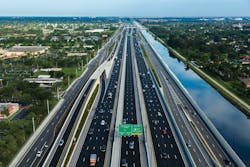Americans have long paid a premium for reliability. When we want to ensure an important package arrives at its destination by a certain date and time, we pay extra to get it there overnight. If we do not want a layover or the risk of arriving late for an appointment in another city, we pay extra for a nonstop flight.
Now, that same value proposition is being applied to our highway system in the form of priced managed lanes.
Historically, we have addressed urban congestion by adding new lanes. But building our way out of congestion is no longer an option. Adding general-purpose lanes comes with an astronomical price tag. Even worse, new capacity might relieve congestion for five, maybe 10 years, but the law of latent demand says eventually those new lanes will become congested as well.
As urban congestion increases and federal funding dwindles, managed lanes as a congestion-management tool have emerged over the past 10 years and continue to evolve and transform. In the 1970s the term “managed lane” typically evoked images of high-occupancy vehicle (HOV) or carpool lanes. But HOV lanes have transformed through the years to high-occupancy toll lanes or tolled managed lanes—allowing HOV ridership to travel free while single-occupancy vehicles use the lanes for a fee—to priced managed lanes, which may require all users to pay.
Price = growth
As vehicle miles traveled increase, priced managed lanes are becoming a more common congestion-fighting strategy in surface transportation. Today, there are 32 operational priced managed lane facilities in the U.S. Thirty-two more are in design or under construction, and another 15-plus are in the planning phase.
To understand the history and evolution of priced managed lanes, it is important to understand the federal support these facilities have received. The following developments contributed to their momentum:
1991-1997: Intermodal Surface Transportation Efficiency Act
- Introduced the Congestion Pricing Pilot Program, which allowed DOTs to submit corridors as pilot HOV projects and to seek federal funding for the establishing, maintaining and monitoring of lanes.
1998-2003: Transportation Equity Act for the 21st Century
- Replaced the Congestion Pricing Program with the new Value Pricing Pilot Program (VPPP);
- Promoted efficient use of highways and supported congestion reduction, air quality and transit productivity goals;
- Limited funding for the implementation of 15 projects; and
- Allowed the use of tolls on the interstates and permitted vehicles with fewer than two occupants to pay a user fee.
Bird’s eye view of a managed-lane interchange on I-495 in Virginia. Photo: Dan Poyourow, courtesy HNTB
2005-2009: Safe, Accountable, Flexible, Efficient Transportation Equity Act: A Legacy for Users
- Represented the largest impact to the evolution of priced managed lanes;
- Retained the Interstate System Reconstruction and Rehabilitation Pilot Program, which allowed tolling on up to three existing interstate facilities to fund needed reconstruction or rehabilitation;
- Updated the VPPP with area-wide pricing, pricing of multiple or single facilities or corridors, single-lane pricing and other market-based strategies, and continued grant funding at $12 million per year;
- Created the Interstate System Construction Toll Pilot Program, which authorized up to three toll pilot facilities on interstates for the purpose of constructing new interstates; and
- Added the new Express Lanes Demonstration Program, which permitted tolling on 15 selected projects to manage high levels of congestion, reduce emissions in nonattainment areas or finance new interstate lanes for the purpose of reducing congestion.
2013–2014: Moving Ahead for Progress in the 21st Century Act (MAP 21)
- Granted authority to convert HOV lanes to high-occupancy toll (HOT) lanes and add new tolling capacity to interstates, provided no general-purpose lanes were removed;
- Removed the requirement of an executed agreement with the U.S. DOT prior to tolling;
- Expanded the Interstate System Construction Toll Pilot Program and Express Lanes Demonstration Program;
- Continued the VPPP and Interstate System Reconstruction and Rehabilitation Pilot Programs, but ended grant funding for the VPPP; and
- Required toll interoperability by 2016.
2016–2020:Fixing America’s Surface Transportation Act (FAST Act)
- Formally recognized the need to replace the federal fuel tax and encouraged states to specifically experiment with user-based solutions;
- Set new use-it-or-lose-it time limitations for participants in the Interstate System Reconstruction and Rehabilitation Pilot Program;
- Added provisions that required state DOTs to consult regional metropolitan planning organizations about the placement and amount of toll lanes on interstate facilities within their regions; and
- Allowed the degradation of HOV lanes in certain cases (i.e., states did not have to give priority to HOVs in program lanes).
Proactive and supportive federal legislation has allowed transportation agencies, metropolitan planning organizations and cities to address congestion in broader terms, using input from the public and transportation officials to structure policies and operational strategies to address congestion.
Real-time pricing on Virginia’s I-95. Photo: Dan Poyourow, courtesy HNTB
Managed movement
In the late 1970s, American motorists were introduced to the first HOV lane. Although HOVs worked well in the beginning, by the 1990s their effectiveness had leveled off, and some lanes began to appear empty, a frustrating sight to motorists crawling along in the adjacent, congested general-purpose lanes.
But with the surplus, pioneering agencies saw an opportunity. The Orange County Transportation Authority (S.R. 91, operational in 1995), Minnesota Department of Transportation (I-394, operational in 2005), Washington State Department of Transportation (S.R. 167, operational in 2008), and others began selling the excess capacity to single-occupancy vehicles, signaling the birth of HOT lanes. Typically, these were single-lane HOV facilities converted to HOT-lane facilities that allowed HOV to ride for free. The goal was to maximize vehicle occupancy and throughput in the corridor, optimize the use of HOV lanes and encourage growth of alternative modes.
Later implementers of HOT lanes included Houston Metro, which converted five HOV lanes to HOT-lane corridors, representing the largest conversion project in the U.S. These HOT lanes operated as reversible lanes and were used primarily to carry suburban residents to and from downtown employment.
As populations grew in large metropolitan cities, congestion grew too—not just during peak travel hours and not only in one direction, but all day in every direction. Cities, under the authority of MAP-21, combatted the full-time congestion by constructing a lane along an existing congested corridor and operating it as an express lane.
Many express-lane facilities became oversubscribed, and agencies began considering new strategies to maintain trip and speed reliability. Concepts included varying toll rates (dynamic pricing) and manipulating HOV eligibility requirements to regulate demand. Sophisticated tolling technologies offered increased lane-management options and allowed transportation agencies to balance throughput with revenue generation. Although priority was given to HOV users, some facilities in Dallas, for example, implemented regional policies, charging all users and giving discounted rates to HOVs. Because of congestion and demand in Houston, several facilities migrated from HOV2+ to HOV3+ requirements.
As more and more large, urban U.S. cities implement priced managed lanes, transportation agencies are expanding them into networks of managed lanes, moving people and goods to and around the cities, not just to and from downtown employment.
Managed lane networks present a new set of challenges in balancing driver expectations and regional consistency with strategies that vary enough to manage the specific demand and travel patterns of each corridor.
Digital signage in place on California’s I-15. Photo: Pedigo photography, courtesy HNTB
Successful facilities need purpose
One of the most critical steps in establishing managed lanes is to set and understand the facility’s intended use and goal. In addition, agencies must operate within federal and state policies, requirements and legislation.
Most priced managed lane facilities are designed to meet one or more of the following primary objectives:
- Relieve congestion and improve mobility;
- Increase/improve transit mobility in the corridor; and
- Generate revenue to cover the facility’s operation and maintenance and, possibly, the capital costs as well as improvements to the general-purpose lanes.
The goals and purpose of priced managed lanes often mirror the goals and purpose of the agencies that implement them. For example, Houston Metro operates five express-lane facilities, which are governed by policies that support its overall goal of mobility and transit trip reliability. Metro’s policies give transit and HOVs priority during peak hours and completely restrict single-occupancy vehicles during peak times because of high HOV demand. In addition, Metro’s managed lane facilities are designed specifically for transit buses with entrances and exits next to park-and-ride lots.
The Texas Department of Transportation, in coordination with the Dallas/Ft. Worth Regional Transportation Council (RTC), sought a dual goal of mobility enhancements and funding for needed improvements and expansion within the corridor. The region was able to leverage priced managed lane revenue to support operations and maintenance of the lanes, construct new lanes and reconstruct the general-purpose lanes within the corridor. RTC policies that support this dual goal include:
- Dynamic pricing to be implemented after the first six months of operation;
- Free ridership for transit vehicles;
- Full toll rates charged for single-occupant and two-occupant vehicles;
- 50% discount to HOV2+ during peak periods;
- No discounts for “green” vehicles; and
- Higher rate for multi-axle vehicles.
The Colorado Department of Transportation also leveraged revenue from priced managed lanes to increase lane capacity through managed lanes on U.S. 36 and I-25.
Although priced managed lanes have the opportunity to assist in offsetting operation and maintenance costs and, in some cases, partial or full capital costs, few managed lanes are completely self-financed or funded. As a result, priced managed lanes should not be viewed solely as a toll financing/funding initiative but as a congestion-management tool.
Initially, priced managed lanes were corridor-specific; however, as congestion continues to build in many urban areas, networks of managed lanes are being considered. In fact, many agencies have migrated to common regional policies while allowing flexibility within the corridor to manage congestion. Agencies have found it helpful to work with the public and partners to achieve common policies in:
- User eligibility: Should HOVs, trucks or transit be allowed to use the facility?
- Pricing structures: Should HOVs and/or low-emission vehicles ride for free or at a reduced rate? Should we set a maximum or minimum toll rate? Should price be set by time of day or should it be dynamic?
- Operation: With what strategies and how frequently will the facility be enforced? Should transponders be mandatory? Will pay-by-mail be allowed? What are the fees to be charged? and
- Engineering: How many access and egress points will the facility have? What are their locations? How will lanes be separated?
The answers to these questions can lead to public support and a successful priced lane implementation. The point is: Each entity operates its facility differently according to its respective mission. Therefore, each priced managed lane will be unique.
There are a few tried and true rules that DOTs can adhere to in order to achieve success. Policy decisions should not be made in a vacuum. One of the biggest pitfalls in policymaking is failing to consider how each decision might affect other aspects of the facility. For example, pay-by-mail can add complexity and cost to toll collection but convenience to the customer; whereas, requiring all users to have a transponder decreases collection costs.
Pricing policies, such as time-of-day pricing, create consistency and help manage public expectations, but do not actively adjust to changes in traffic conditions, whereas dynamic pricing would. Enforcement, whether through lane self-declaration or active police patrols, can lead to different engineering strategies and operational costs.
A facility can—and should—outgrow its original policies. Policy decisions are not static. They will and must evolve over time for the managed lanes to continue to function effectively. For example, Minnesota’s I-394 Express Lanes opened with an off-peak toll of $0.25 per section, but because of public sentiment, adjusted off-peak tolls approximately three weeks later.
Priced managed lanes will never solve the chronic problem of urban congestion on their own, but governed by the right goals and supporting policies these facilities can help owners continue to advance their missions of mobility.



